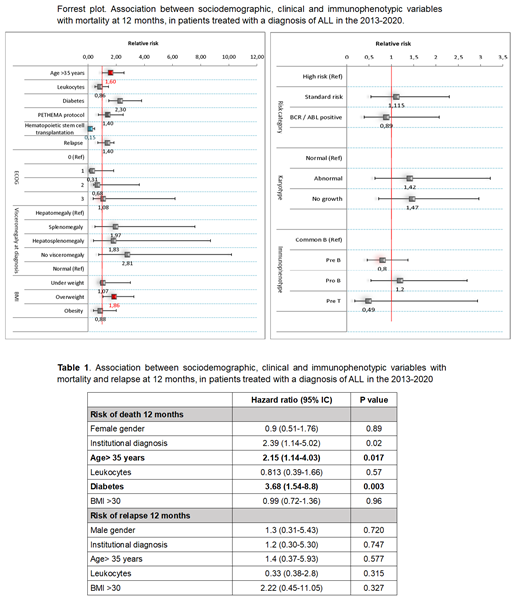Abstract
INTRODUCTION
Acute lymphoblastic leukemia (ALL) is a clonal hematopoietic disorder that originates from B or T lymphoid progenitors. It affects more frequently children, but prognosis is worse in adults. ALL has a high incidence in Hispanics (Swords R et al. Blood Cancer J. 2016) and is important to identify baseline clinical, sociodemographic, and cytogenetic characteristics in these patients that are relevant for relapse free and overall survival. Reports of Hispanic patients with ALL outsides of the U.S.A are scare but are important to further characterize the impact of this disease in minority populations.
OBJETIVE
To describe the association between sociodemographic, clinical and immunophenotypic variables with 12-month relapse free survival (RFS) and overall survival (OS) in patients diagnosed and treated for ALL in a Colombian university hospital (FOSCAL).
MATERIALS AND METHODS
This is a descriptive observational cohort study that included patients older than 18 years with a confirmed diagnosis of ALL treated in a tertiary university hospital between 2013-2020 and that had at least 12 months follow-up after starting treatment. Baseline sociodemographic, clinical, laboratory and immunophenotypic data were collected. Bivariate analyses of both relapse and mortality cumulative incidences at 12 months, with relative risks (RR) and their 95% Confidence intervals were performed, using either chi-square or Fischer exact test when needed. In a second term, bivariate survival analyses through Kaplan-Meier survival function and Hazard ratios were evaluated, using Cox proportional hazards as the main statistical test.
RESULTS
Among 128 of include patients, the median age at diagnosis was 34 years (range 0-89 years), 54% were men, 6.2% had type 2 Diabetes Mellitus (T2DM), most had an ECOG PS of 0 (72.7%), 31.8% had splenomegaly, 12% had hepatomegaly and 47% presented without organomegalies. The proportion of patients with overweight and obesity were 26.3% and 22.2% respectively. At diagnosis 80.5% and 8.8% of patients had high risk and standard risk ALL, respectively Forty-eight patients had a FAB classification with 58% being ALL-2 and most of the were unclassified. Most cases (81%) had B-cell immunophenotype, with 55% being pre-B-cell and 32% mature B-cell. Twelve percent of patients were Ph+ B-ALL. At 12 months, the proportion of mortality was 34.4%. Most of the patients (83%) did not have major co-morbidities, however patients with T2DM had a significantly inferior survival at 12 months, HR: 3.68 (95%CI 1.54-8.8 P=0.003), as patients older than 35 years (HR: 2.15, 95%CI: 1.14-4.0, P=0.017) (Table 1).
CONCLUSIONS
Colombian patients with B-cell ALL have similar clinical, immunophenotypic and cytogenetic (Ph+ prevalence) characteristics as seen in other international cohorts. In our cohort patients older than 35 years and subjects with T2DM had inferior survival at 1 year. Further analyses of socioeconomic factors, molecular features and response to specific regimens are needed to have a better understanding of Colombian B-ALL patients.
Salazar: Amgen: Research Funding. Peña: Amgen: Research Funding. Sandoval-Sus: BMS: Other: Advisory Board, Speakers Bureau; SeaGen, Janssen, MassiveBio, TG: Other: Advisory Board. Sossa: Amgen: Research Funding.


This feature is available to Subscribers Only
Sign In or Create an Account Close Modal